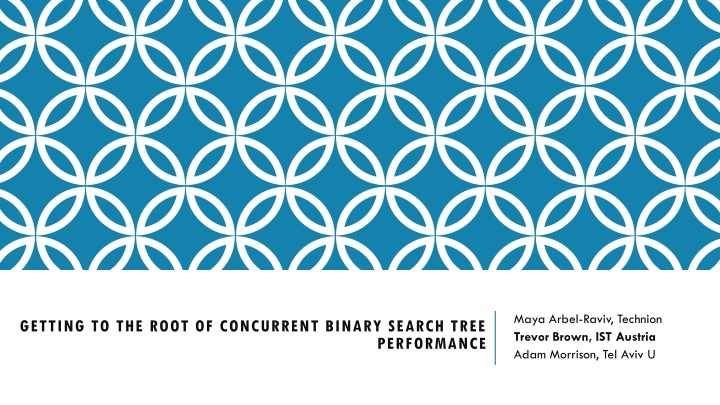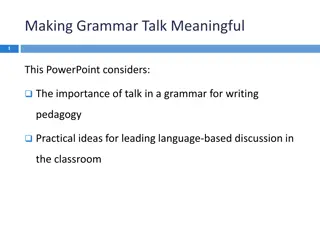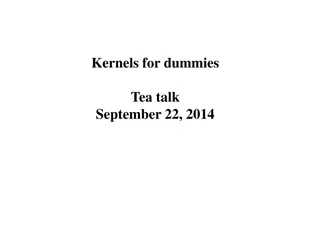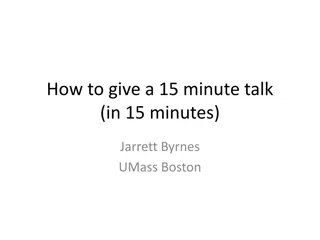
Concurrent Binary Search Tree Performance Study
"Explore the performance of optimistic concurrent search trees in various applications such as in-memory databases and internet routers. Compare different variants of binary search trees to understand their efficiency and implementation issues for high performance."
Download Presentation

Please find below an Image/Link to download the presentation.
The content on the website is provided AS IS for your information and personal use only. It may not be sold, licensed, or shared on other websites without obtaining consent from the author. If you encounter any issues during the download, it is possible that the publisher has removed the file from their server.
You are allowed to download the files provided on this website for personal or commercial use, subject to the condition that they are used lawfully. All files are the property of their respective owners.
The content on the website is provided AS IS for your information and personal use only. It may not be sold, licensed, or shared on other websites without obtaining consent from the author.
E N D
Presentation Transcript
Maya Arbel-Raviv, Technion Trevor Brown, IST Austria Adam Morrison, Tel Aviv U GETTING TO THE ROOT OF CONCURRENT BINARY SEARCH TREE PERFORMANCE
MOTIVATION Optimistic concurrent search trees are crucial in many applications (e.g., in-memory databases, internet routers and operating systems) We want to understand their performance We study BSTs because there are many variants, making comparisons easier
BST PROTECTED BY A GLOBAL LOCK Synthetic experiment: Insert 100,000 keys, then n threads perform searches
HAND-OVER-HAND LOCKING (HOH) Same experiment
LOCKING AND CACHE COHERENCE Evict this cache line for all threads! Evict this cache line for all threads! a m Algorithm L2 misses / search L3 misses / search Global lock 15.9 3.9 HOH 25.1 7.7
ACHIEVING HIGH PERFORMANCE NO locking while searching! Example: Unbalanced DGT BST Standard BST search No synchronization!
STATE OF THE ART BSTS BST Balanced? Tree type Search overhead BCCO Y Internal* Read per-node Blocking DVY Internal* AA Internal Write per-search DGT External HJ Internal Read per-node Lock-free RM Internal Read per-search NM External EFRB External Not covered: lock-free balanced BSTs
HOW DO THEY PERFORM? EXPERIMENT: 100% SEARCHES WITH 64 THREADS Internal Balanced External BCCO1 BCCO2 HJ DVY RM AA NM1 NM2 DGT EFRB Read per-node Read per-node Read per-node Read Write per-search Search overhead per-search
BASIC IMPLEMENTATION ISSUES Bloated nodes Why does node size matter? Larger nodes fewer fit in cache more cache misses Scattered fields Why does node layout matter? Searches may only access a few fields Scattered fields more cache lines more cache misses Incorrect usage of C volatile Missing volatiles correctness issue Unnecessary volatiles performance issue
IMPACT OF FIXING THESE ISSUES Internal Balanced External BCCO1 BCCO2 HJ DVY RM AA NM1 NM2 DGT EFRB Read per-node Read per-node Read per-node Read Write per-search Search overhead per-search X X X X X X X Bloated nodes Scattered fields Incorrect C volatile X X X X X X X X X
HOW A FAST ALLOCATOR WORKS Jemalloc: threads allocate from private arenas Each thread has an arena for each size class: 8, 16, 32, 48, 64, 80, 96, 112, 128, 192, 256, 320, 384, 448, 512, Jemalloc per-thread allocation <---- 4096 byte page ----> malloc(48) malloc(36) malloc(40) malloc(44) malloc(32) malloc(17) malloc(40) malloc(33) 8 16 Arenas 0 32 32 ... 4048 0 96 144 192 48 48 64
CACHE LINE CROSSINGS These nodes cross cache lines! 8 16 32 48 0 16 64 96 32 0 32 0 96 144 48 48 0 64 128 192 Fixing bloated nodes can worsen performance! 64 Cache line Cache line Cache line Cache line Not a big deal if the tree fits in the cache If the tree does not fit in cache, double cache misses for half of your nodes!
CACHE SETS Hashing a cache line to a bucket: physical address mod 4096 Cache is sort of like a hash table Maps addresses to buckets (4096 for us) Buckets can only contain up to c elements (64 for us) If you load an address, and it maps to a full bucket A cache line is evicted from that bucket Mod 4096 is not a good hash function Patterns in allocation can lead to patterns in bucket occupancy
CACHE SET USAGE IN HJ BST Insert creates a node and a descriptor (to facilitate lock-free helping) Node size class: 64 Descriptor size class: 64 128 256 0 64 192 320 64 Cache line Cache line Cache line Cache line Cache line Cache line Which cache sets will these nodes map to? Cache indexes used: 0, 2, 4, (only even numbered indexes) Taken modulo 4096, these can only map to even numbered cache sets! Only half of the cache can be used to store nodes!
SIMPLE FIX: RANDOM ALLOCATIONS Hypothesis: problem is the rigid even/odd allocation behaviour 128 256 0 192 320 64 Idea: break the pattern with an occasional dummy 64 byte allocation dummy 256 0 192 320 64 Fixes the problem! Reduces unused cache sets to 1.6% Improved search performance by 41% on our first experimental system, which was an AMD machine. However, on an Intel system, this did not improve search performance!
THE DIFFERENCE BETWEEN SYSTEMS Intel processors prefetch more aggressively Adjacent line prefetcher: load one extra adjacent cache line Not always the next cache line (can be the previous one) Smallest unit of memory loaded is 128 bytes (two cache lines) This is also the unit of memory contention
EFFECT OF PREFETCHING ON HJ BST The occasional dummy allocations break up the even/odd pattern But dummy 256 0 192 320 64 Whenever search loads a node, it also loads the adjacent cache line This is a descriptor or a dummy allocation! This is useless for the search Only half of the cache is used for nodes Fix: add padding to nodes or descriptors so they are in different size classes
SEGREGATING MEMORY FOR DIFFERENT OBJECT TYPES 1. Previously described solution Add padding so objects have different size classes 2. A more principled solution Use multiple instances of jemalloc Each instance has its own arenas Allocate different object types from different jemalloc instances 3. An even better solution Use an allocator with support for segregating object types
PERFORMANCE AFTER ALL FIXES Internal Balanced External BCCO1 BCCO2 HJ DVY RM AA NM1 NM2 DGT EFRB Read per-node Read per-node Read per-node Read Write per-search Search overhead per-search node size class 32 bytes node size class 48 bytes
APPLICATION BENCHMARKS In-memory database DBx1000 [Yu et al., VLDB 2014] Yahoo! Cloud Serving Benchmarks TPC-C Database Benchmarks Used each BST as a database index Merges the memory spaces of DBx1000 and the BST! Creates similar memory layout issues (e.g., underutilized cache sets) And new ones (e.g., scattering of nodes across many pages) Even accidentally fixes memory layout issues in DBx1000 See paper for details
RECOMMENDATIONS When designing and testing a data structure Understand your memory layout! How are nodes laid out in cache lines? Pages? What types of objects are near one another? http://tbrown.pro Tutorials, code, benchmarks When adding a data structure to a program You are merging two memory spaces Understand your new memory layout! Companion talk: Good data structure experiments are R.A.R.E New tools needed?






















